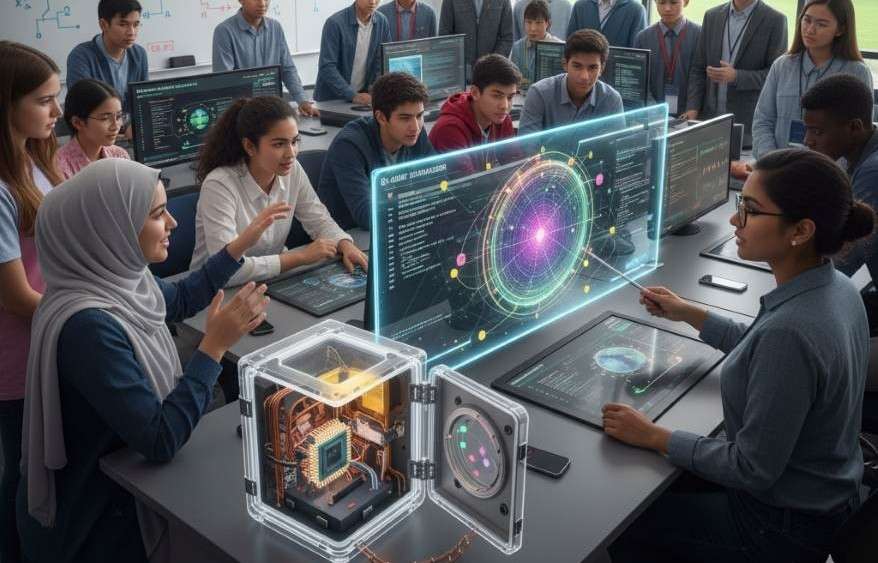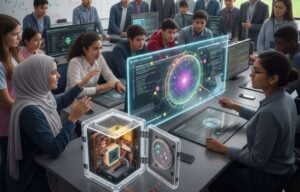Quantum Computing and Quantum Communication: Shaping the Future
Estimated reading time: 12 minutes
Quantum theory is the fundamental framework that describes the behavior of matter and energy at the smallest scales, such as atoms, electrons, photons, and all elementary particles. Unlike everyday objects, which follow the familiar rules of classical physics, particles in the quantum world obey different rules. It reveals that particles can exist in superpositions, form mysterious links through a phenomenon known as entanglement, and behave in ways that defy classical intuition.
This theory not only explains the structure of atoms and the stability of matter but also underpins much of modern technology, including semiconductors, lasers, and MRI machines. Today, quantum theory forms the foundation of emerging fields like quantum computing, quantum communication, and quantum sensing, which promise to revolutionize science, technology, and our understanding of the universe itself.
Quantum computing uses these strange properties of quantum mechanics to process information in a fundamentally new way. Instead of the usual binary bits of 0 or 1, quantum computers use quantum bits or qubits, which can be both 0 and 1 simultaneously. This ability enables quantum computers to solve certain complex problems much faster than the most powerful classical computers, opening doors to revolutionary advances in fields like medicine, cryptography, and materials science.
Quantum World
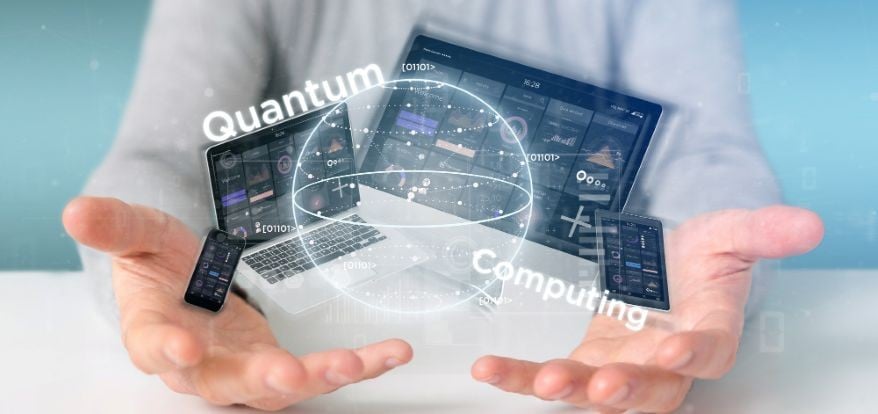
Have you ever thought about what goes on inside your smartphone or laptop? At its heart, it’s a world of tiny switches, billions of them, flipping on and off at incredible speeds. These switches, called “bits,” are the language of our digital world. They can either be a 0 (off) or a 1 (on). Every photo you take, every video you watch, every message you send is, deep down, just a very, very long string of these zeros and ones. For the last fifty years, our mission has been simple: make these switches smaller and faster. And we have been incredibly successful as the last century has witnessed a revolution in information technology.
But we are now approaching a limit. We are trying to build switches that are the size of just a handful of atoms. When you get that small, the world starts to behave in very strange ways. The familiar rules of physics that govern a cricket ball or a speeding car break down, and we enter a new, weird, and wonderful realm: the quantum world. For a long time, this weirdness was seen as a problem—a barrier to making our computers even smaller. But what if, instead of fighting it, we used it? What if we built a new kind of computer that speaks the language of the quantum world?
From Bit to Qubit
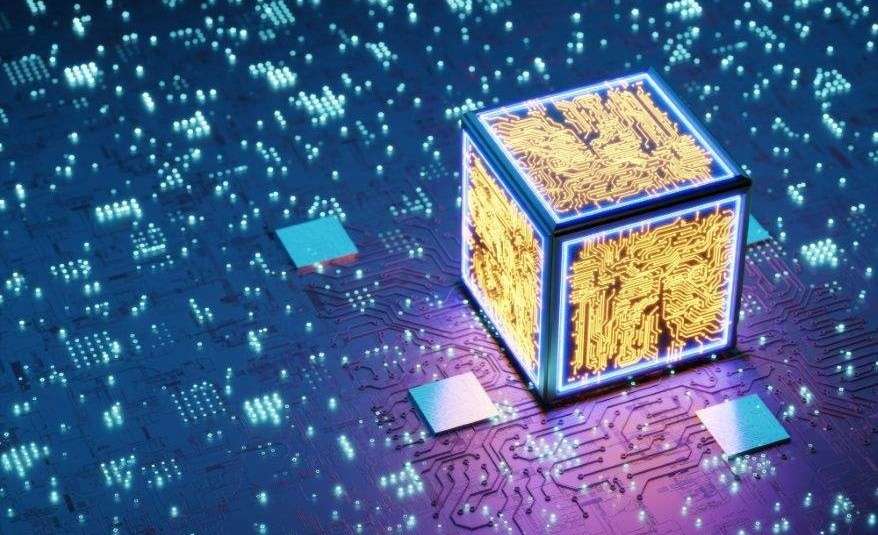
To understand a quantum computer, we first need to understand its basic building block. In a normal computer, this is the bit (the 0 or 1). In a quantum computer, it is the quantum bit or qubit.
Imagine a bit like a light switch. It can be off (0) or on (1). Thus, there is no in-between. At any given time, a classical bit is in a definite state.
To give a rough analogy, imagine a qubit is like a spinning coin. While it is spinning, is it heads or tails? The truth is, it is a blur of both at the same time. Moreover, it only settles on one answer, i.e., `heads’ or `tails’ when you stop it and look. This magical “both-at-once” state is called superposition.
A qubit can be a 0, a 1, or it can be in a superposition of both 0 and 1 simultaneously. This is its first distinct feature we see. It is not just an “either/or” switch; it’s a “both-and” switch. This ability to hold multiple values at once is what gives quantum computers their incredible potential. Thus, this is often called parallelism because we are able to access both 0 and 1 at the same time.
Spooky Connections: Entanglement
If superposition was not strange enough, the quantum world has another trick up its sleeve called entanglement. Therefore, this was first introduced by none other than Schrodinger. The great scientist Albert Einstein realized the strange features of entanglement and famously called it “spooky action at a distance,” and for good reason.
Imagine you have two “magic” coins that are entangled. You give one to your friend and fly to the other side of the world. Your friend flips their coin and it lands on heads. The moment he sees that result, he knows that your coin has instantly landed on tails even though you are thousands of kilometres away. Hence, there is a mysterious, invisible connection between them. Knowing the state of one instantly can tell the state of the other. Though this by itself cannot be used to send signals faster than light.
Qubits can be entangled in the same way. If you have two entangled qubits, their fates are linked. If you measure one and find it is a 0, you instantly know its partner is a 1. This connection allows quantum computers to perform incredibly complex calculations where the information is shared and processed across multiple qubits in a way that is simply impossible for classical computers. Quantum entanglement also offers a magical trick to perform quantum communications that cannot be achieved classically.
Massive Parallelism: The Exponential Power
Qubits exist in multiple states at once due to the superposition principle and link mysteriously through entanglement. Why does that lead to such a massive leap in computing power?
The answer is exponential growth.
- 1 classical bit can be in 1 state (0 or 1).
- 1 qubit can be in 2 states at once (0 and 1).
- 2 classical bits can be in 1 of 4 possible combinations (00, 01, 10, or 11).
- 2 entangled qubits can be in all 4 of those combinations at the same time.
- 3 entangled qubits can be in all 8 possible combinations at once.
- 4 entangled qubits can be in all 16 possible combinations at once.
Do you see the pattern? Every time you add one more qubit, the number of states it can explore doubles. Moreover, a computer with just 50 reliable qubits could explore more states than the most powerful supercomputer on Earth. A computer with around 300 qubits can represent more combinations than the total number of atoms in the known universe.
It is important to understand that this does not mean a quantum computer will make your video games load faster or your videos stream better. Hence, your laptop is already fantastic at those tasks. Instead, quantum computers are designed to solve a completely different class of problems, i.e., problems that are so complex, so massive, that it would take a normal computer billions of years to even begin to solve them.
Use of Quantum Computer
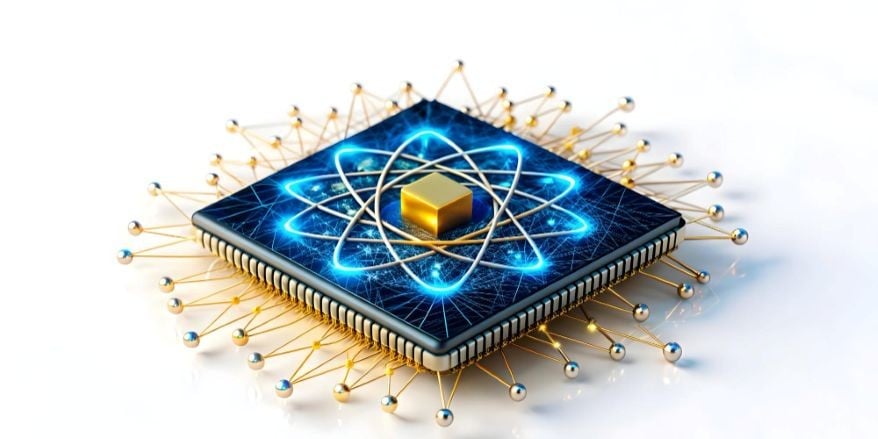
What are these grand challenges that quantum computers could tackle?
1. Discovering New Medicines and Materials: Designing a new drug involves understanding how a complex molecule will interact with the proteins in our body. Simulating a single complex molecule is an impossibly hard task for even our best supercomputers. A quantum computer, however, operates on the same quantum rules as the molecule itself. It could simulate these interactions perfectly, allowing us to design life-saving drugs or create revolutionary new materials—like a catalyst that efficiently captures carbon dioxide from the atmosphere or a material that can conduct electricity with zero resistance at room temperature.
2. Revolutionizing Artificial Intelligence: AI and machine learning are all about finding patterns in vast amounts of data. Quantum computers could supercharge this process, allowing AI to solve much more complex problems and learn much faster.
3. Breaking and Making Codes: Here lies a double-edged sword. The way we protect our data online, from bank transfers to private messages, relies on a type of encryption that is very hard for classical computers to break. A powerful quantum computer could, in theory, break this encryption easily. This is a major security risk, but quantum physics also offers the solution: quantum communication. Using the principles of quantum mechanics, we can create communication channels that are physically impossible to eavesdrop on, leading to a new era of unhackable security.
The Challenges
If quantum computers are so powerful, why aren’t they everywhere? The truth is, building them is one of the hardest engineering challenges humanity has ever faced.
The powers of a qubit, such as superposition and entanglement, are incredibly fragile. The slightest disturbance from the outside world, like a tiny vibration or a temperature change, can destroy the quantum state and ruin the calculation. Thus, this is called decoherence. It is like trying to get a spinning coin to stay perfectly balanced, but the table is constantly shaking.
To protect the qubits from this decoherence, scientists have to go to extreme lengths. Many quantum computers look like giant, beautiful chandeliers. These super-refrigerators, called cryostats, cool the quantum chips to temperatures colder than deep space. Just a fraction of a degree above absolute zero (-273.15 °C). There are also other physical systems where we can identify qubits that can work at room temperature. But that is an active area of research.
Quantum Communication:
While quantum computers promise to break our current forms of encryption, the same quantum weirdness also offers a way to create perfectly secure communication that is physically impossible to hack.
Imagine trying to send a secret message not as a stream of regular electronic bits, but as a series of individual particles of light, or photons, each prepared in a delicate quantum state. This is the basis of quantum communication. Its incredible security guarantee comes from a fundamental law of nature called the No-Cloning Theorem. This theorem states that you cannot create an exact copy of an unknown quantum state. Think of a quantum message like a fragile soap bubble.
A hacker trying to intercept and copy it would be like someone trying to touch the bubble to see its shape; their very act of measurement would instantly pop it, altering the state and leaving behind an unmistakable trace of their eavesdropping. The intended recipients would immediately recognize that someone had compromised their line, making the security not just strong but provably perfect.
This principle is complemented by another profound rule, the No-Deleting Theorem. This acts as the other side of the same coin. Just as you cannot perfectly clone a quantum state, this theorem proves that you cannot perfectly delete one of two identical copies of a quantum state, leaving the other undisturbed. Together, these two laws establish that the universe deeply conserves quantum information and does not allow anyone to secretly copy or erase it without consequences.
Quantum Internet
This ensures the absolute integrity of a quantum message from start to finish. These theorems are the twin pillars upon which our future secure networks. Often called the “Quantum Internet,” it will be built. They guarantee that information can be shared with the confidence that it is protected. Hence, not by complex mathematical problems, but by the fundamental and unbreakable laws of physics itself.
To build a true “Quantum Internet,” we need a reliable way to send fragile quantum information between distant nodes. Simply sending a qubit down a fiber optic cable is incredibly difficult, as the slightest environmental interference can destroy its delicate state. This is where the astonishing processes of quantum teleportation and remote state preparation become essential.
Quantum Teleportation:
This may sound like something from science fiction. This is not about beaming matter, but about perfectly transferring the exact quantum state of a particle onto another particle far away. It uses a pair of pre-shared entangled particles as a “quantum channel” to transmit this information, destroying the original state in the process, which guarantees the security of the transfer.
In a typical protocol, two parties, Alice and Bob, share an entangled pair beforehand. Alice performs a joint measurement on her particle and the unknown state, then sends two classical bits of information to Bob. Using this information, Bob applies a corresponding operation on his particle, which then becomes a replica of the original state. Quantum teleportation demonstrates how systems can faithfully transmit quantum information across space, even though no faster-than-light communication occurs. Thus, it forms the basis for quantum communication, quantum networks, and future quantum internet technologies.
Remote State Preparation:
A related and often more efficient tool is Remote State Preparation (RSP), where one art aims to prepare that exact state in a distant lab. Remote State Preparation is a quantum communication protocol closely related to quantum teleportation. But with a key distinction: the sender (Alice) already knows the quantum state to be transmitted, unlike in teleportation, where the state is unknown. In RSP, Alice and Bob share an entangled pair of particles beforehand.
By performing a specific measurement on her particle and sending a smaller amount of classical information to Bob (often less than two bits), Alice can help Bob prepare the desired quantum state at his distant location without physically transmitting the particle. This protocol highlights how quantum entanglement and classical communication together can enable efficient transfer of quantum information, and serves as a foundation for practical implementations in quantum networks, distributed quantum computing, and secure communication systems.
These are not just theoretical curiosities; they are the practical, foundational protocols that will act as the engines of a quantum network, allowing us to move quantum information between processors, link quantum sensors, and create a truly global and secure quantum communication system.
The Dawn of the Quantum Age:
Quantum technology is more than just building quantum computers. It is a vast area of research that includes Quantum Computing, Quantum Communication, Quantum Sensing, and many more. We are still in the early days of this revolution, much like the 1950s were for classical computers. The quantum computers we have today are big, expensive, and can only handle a small number of qubits. But the progress is incredibly fast. This new technology will not replace your laptop. It will be a specialized tool. Quantum science is opening doors to discoveries and inventions previously thought impossible. By learning about quantum technology now, you are preparing for a world full of surprises and new opportunities.
Whether you become a quantum scientist, an engineer, or simply a knowledgeable citizen, understanding quantum ideas will be a superpower in the years to come. Stay curious—because the quantum revolution has begun!
Additionally, to stay updated with the latest developments in STEM research, visit ENTECH Online. Basically, this is our digital magazine for science, technology, engineering, and mathematics. Furthermore, at ENTECH Online, you’ll
